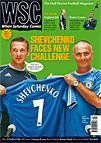 While Italy was going wild after the penalty shootout success against France in Berlin, the real celebrations should have been in South America. Ian Plenderleith reveals who are the true top dogs
While Italy was going wild after the penalty shootout success against France in Berlin, the real celebrations should have been in South America. Ian Plenderleith reveals who are the true top dogs
It goes without saying that Scotland are the greatest football nation of all time. That they have now been statistically declared as world champions no fewer than 85 times only serves to confirm what all tartan-blooded people have always maintained, and if you look at the website of The Unofficial Football World Championships then you’ll understand why.
The website was inspired by the Scottish conceit that beating England at Wembley in 1967 as good as made them world champions. This set a team of (mainly English) philosophers, fans and statisticians into wondering who would be world champion most often if, going back to the dawn of international football, the game’s top country was worked out in the same way as, say, a world boxing title. That is, whoever beats the reigning champion automatically takes over as king.
Right now it’s Uruguay, who didn’t let a small setback like failing to qualify for Germany 2006 prevent them from rising to the top by beating holders Romania back in May. Since then they’ve beaten the might of Libya and Tunisia (on penalties) and held off Serbia to hold on to a non-existent trophy and spark off months of endless celebrations on the streets of Montevideo. Other recent champions include Angola, Zimbabwe and the Republic of Ireland, though the Scots’ barren run, fuelled by post-Victorian era complacency, has now lasted almost 40 years.
Maybe if Duncan Ferguson had fulfilled his potential instead of drowning it in lager, things might have been different for the Scots of late. That Dunc’s idea of fuelling for a game was a skinful of ale meant a diminished capacity for making it through 90 minutes, but also led to him holding Everton’s record for substitute appearances (82). This information comes from a new website called Everton Results, self-deprecatingly billing itself as “yet another Everton website”, but which catches the eye in much the same way as the unofficial World Cup site – it’s full of meaningless but addictive historical numbers and comparisons.
For example, it might seem like a waste of any sane human being’s time to look up what Everton’s highest attendances in European competition are, but no sooner have you clicked on the link than you find yourself gawping in amazement that in 1962 they played in front of 40,240 against Dunfermline in the Fairs Cup. You can then mentally file this fact away for any number of future discussions, the nature of which neither the site, nor this column, is at liberty to reveal.
There are no numbers, but plenty of verbals at Sidenetting, another start-up site trying to be funny about football, with the usual half-successful results. The site’s strong point is its documentation of the worst TV pundits, ruthlessly transcribing all the erms and ahhs of hesitation that litter the output of the nervous and the inarticulate. However, the excerpts speak for themselves and the commentaries on the commentaries are superfluous.
The rest of the content is lively, if laddish, and the overall structure is a bit slapdash, with irregular updates. That is, it’s one of those sites you might look at again in a month and find the writers have lost interest and given up. Still, there’s enough potential for them to persevere, and hopefully they’ll expand upon sections such as “Grounds”, where you can see stadiums from unusual perspectives, showing the palm trees outside Wingate and East Finchley FC and the apparent grain silo at Kenilworth Road.
Another new way to look at a ground is to download the Google Earth software and then home in on cities and stadiums of your choice from above. Much of the satellite photography isn’t up to date – Highbury’s still going strong and groundwork on Ashburton Grove hasn’t even started. Wembley hasn’t been finished yet either (oh, hang on…). And Scunthorpe and Hamilton have yet to be photographed, with the space cameras presumably still waiting for a sunny day.
Neither is the detail so magnificent that you’ll be able to pick out your regular seat or exact standing spot, but if you stop zooming in at a certain distance the most interesting aspect is what lies around the stadium rather than the shape of its roof. So the maps act as an unwitting chronicle of changing trends in stadium location, as well as showing you that Leyton FC could do with a new layer of turf.
Some sharper aerial photographs of mainly northern grounds can be found at Webb Aviation, which shows the contrast between a gleaming Old Trafford (which looks like it’s just waiting to be picked up at either end and ripped out of the earth) and a half-finished Blackpool stadium. Manchester City fans may find the picture of the flat landscape where Maine Road used to be a little painful, although not as painful as the prices if you want a real print. Still, they’ll turn out cheaper and more enduring than hiring a helicopter to fly above Ossett Town to get a bird’s eye view of the weird triangular pitch that lies adjacent.
So on to the official Ossett Town site, where a July general meeting voted by an overwhelming majority “to remain at Ingfield for the next five years at least”. In a time when Scotland can be declared the greatest team ever, it’s nice to know there’s some sanity left in the world.
From WSC 235 September 2006. What was happening this month